在硅铝磷酸酯†中稳定的Cu催化剂上,甲烷氧化O2生成HCHO、CO和H2
IF 4.2
3区 化学
Q2 CHEMISTRY, PHYSICAL
引用次数: 0
摘要
以Cu/SAPO为载体,研究了SAPO34负载Cu催化剂对甲烷O2氧化的催化性能。在773 ~ 923 K的温度范围内,Cu/SAPO催化剂除生成CO和HCHO外,还生成H2,而V、Cr、Mn、Fe、CO和Ni等三维过渡金属催化剂对这些产物的生成活性较弱。在与SAPO34不同的沸石(丝光沸石、faujasite、chaab沸石、β -沸石)负载Cu催化剂上也可以生成HCHO、H2和CO,但这些产物的产率,尤其是Cu/SAPO催化剂上的H2产率明显高于其他沸石负载Cu催化剂。在923 K的Cu/SAPO催化剂上氧化,H2、CO和HCHO的产率分别达到2.2%、5.4和0.7%,甲烷转化率为8.2%。用XRD和紫外可见光谱对Cu催化剂进行了表征。高度分散的稳定在SAPO34中的Cu2+是甲烷氧化反应的活性位点,这些Cu2+被甲烷还原为Cu+,被O2氧化为Cu2+,有利于反应的进行。本文章由计算机程序翻译,如有差异,请以英文原文为准。

Formation of HCHO, CO and H2 by methane oxidation with O2 over Cu catalysts stabilized in silicoaluminophosphates†
The catalytic performance of Cu catalysts supported on SAPO34 (denoted as Cu/SAPO) for methane oxidation with O2 has been investigated in detail. Cu/SAPO catalysts formed H2 in addition to CO and HCHO during methane oxidation in the temperature range from 773 and 923 K, while the other 3d transition metal catalysts such as V, Cr, Mn, Fe, Co and Ni were less active for the formation of these products. The formation of HCHO, H2 and CO was also confirmed during the reaction over Cu catalysts supported on zeolites different from SAPO34, such as mordenite, faujasite, chabazite, and beta-zeolite, but the yields of these products, especially the H2 yield in the reaction over the Cu/SAPO catalyst, were significantly higher than those over other zeolite-supported Cu catalysts. In the oxidation over Cu/SAPO catalysts at 923 K, the yields of H2, CO, and HCHO reached 2.2, 5.4, and 0.7%, respectively, at a methane conversion of 8.2%. These Cu catalysts were characterized by XRD patterns and in situ UV-vis spectra. Highly dispersed Cu2+ species stabilized in SAPO34 were the active sites for methane oxidation, which were reduced to Cu+ species by methane and oxidized to Cu2+ by O2 to facilitate the reaction.
求助全文
通过发布文献求助,成功后即可免费获取论文全文。
去求助
来源期刊

Catalysis Science & Technology
CHEMISTRY, PHYSICAL-
CiteScore
8.70
自引率
6.00%
发文量
587
审稿时长
1.5 months
期刊介绍:
A multidisciplinary journal focusing on cutting edge research across all fundamental science and technological aspects of catalysis.
Editor-in-chief: Bert Weckhuysen
Impact factor: 5.0
Time to first decision (peer reviewed only): 31 days
 求助内容:
求助内容: 应助结果提醒方式:
应助结果提醒方式:


